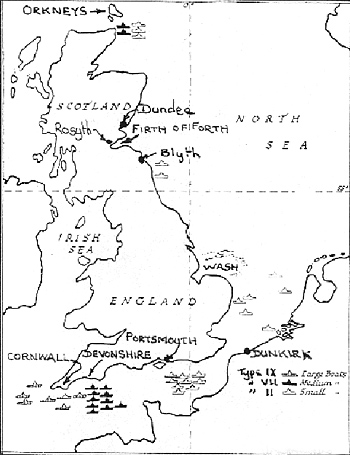Continued from KTB #155. When we left this feature, VIC was writing about the preparations for the U-boats to choke off the Royal Navy. --HC
 Supplies of fuel and torpedoes for these U-boats would be provided at the following bases:
Supplies of fuel and torpedoes for these U-boats would be provided at the following bases:
- 1. For boats operating at the west end of the English Channel, it was Lorient with alternate bases at St. Nazaire and Brest;
2. For boats operating at the east end of the English Channel, it was Cherbourg with Le Havre as an alternate base;
3. For the other boats operating off the east coast of England and the North Sea, it was Rotterdam with den Helder and Flushing as alternative bases.
Because of the way Operation ‘SEALION’ had concentrated the U-boats, it made it possible for British submarines to attack them. Also, the British had changed their ciphers and denied the Germans any further free knowledge. Just as it had been a blow for the British to have their intentions known, it was now a blow to Germany to have this intelligence denied them.
On 17th of August, the O.K.W. (Oberkommando der Wehrmacht, or Armed Forced High Command) announced the ‘total blockade’ of Britain in an operational area around the British Isles. In this area, which is almost identical with the American War Zone, forbidden to American ships and citizens, all ships are to be sunk without warning.
The first notable success against the U-boats deployed for Operation ‘SEALION’ off the French ports by the Bay Patrol was by HMS CACHALOT commanded by Cdr. J. D. Luce. On 19th August, HMS CACHALOT had laid 50 mines south of Penmarch and surfaced that night at 0116 hours on the 20th. Whilst still on the surface, she sighted a U-boat proceeding towards Lorient. It was U-51, commanded by Kapitänleutnant Dietrich Knorr. Only five days earlier, U-51 had sunk the 5,709 ton British tanker SYLVAFIELD and was returning to her base at Lorient.
HMS CACHALOT made a night surface attack and sank U-51. This was the 4th German U-boat to be sunk by British submarines. The others were U-36, U-54 and U-1.
Meanwhile, U-28, U-32, U-101 and U-124 were coming in from Germany while U-37, U-56, U-57, U-59 and U-60 were setting out from Lorient to operate against independently running ships and convoys alike, in the areas between the Hebrides and the North Channel, Ireland and Rockall Bank.
A British force is transferred from Gibraltar. This force was comprised of the battleship HMS VALIANT, the new aircraft carrier HMS ILLUSTRIOUS and the AA cruisers HMS CALCUTTA and HMS COVENTRY. They were accompanied by the cruiser HMS SHEFFIELD and the 8th Destroyer Flotilla, destined for Force “H”. Somehow this task force escaped from being attacked by any U-boats.
On the 27th August 1940, the basic issue dividing the OKH (Oberkommando des Heeres or Army High Command) and the OKM (Oberkommando der Marine or Navy High Command) regarding Operation ‘SEELÖWE’, the invasion of England.
Hitler decides in favor of the ‘smaller solution’ which consists of a landing on a front of approximately 140 kilometers on the British southeast coast between Folkestone and Eastbourne. The same day, two groups of Italian submarines are moved from the Mediterranean to the French Atlantic port of Bordeaux.
Back to KTB # 158 Table of Contents
Back to KTB List of Issues
Back to MagWeb Master Magazine List
© Copyright 2002 by Harry Cooper, Sharkhunters International, Inc.
This article appears in MagWeb (Magazine Web) on the Internet World Wide Web. Other military history articles articles are available at http://www.magweb.com
Join Sharkhunters International, Inc.: PO Box 1539, Hernando, FL 34442, ph: 352-637-2917, fax: 352-637-6289, www.sharkhunters.com
